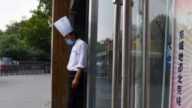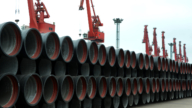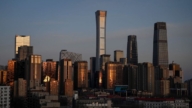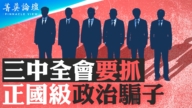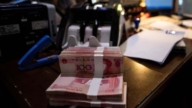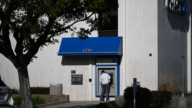【新唐人2014年08月06日訊】日前,大陸社科院一份報告指出,中國經濟今年要保持7.4%增長,需20萬億資金支援,另外新增貸款規模,也可能首次突破10萬億大關。2008年全球金融危機後,中共靠「4萬億」投資拉動經濟的模式,給中國帶來的苦果還沒有償完,要達到中共總理李克強設定的,今年7.5%的GDP增長目標,中共勢必還要以超過以往的規模,繼續加大投資推動經濟。來聽聽專家的分析。
中國社科院7月25號在北京發佈「經濟藍皮書夏季號:中國經濟增長報告(2013—2014)」。報告預測,今年經濟增速為7.4%,是24年來最慢增速。
社科院經濟所副所長張平表示,今年經濟要保持7.4%的增速,沒有20萬億資金下不來。
根據央行數據,今年上半年社會融資規模為10萬5700億元,比去年同期多4146億元。其中,上半年人民幣貸款增加5萬7400億元,同比多增6590億元。
張平預計,今年社會融資總規模將達20萬億元,而新增貸款規模可能超過10萬億元,超過經濟刺激力度最大的2009年,創出歷史新高。
中國金融智庫研究員鞏勝利:「20萬億也很嚇人,因為中國在2008年全球第一次金融海嘯以後,一下子投了4萬億,4萬億到20萬億已經翻了若干倍了。」
大陸財經評論人士牛刀:「貸款超過10萬億。關鍵問題是,它在哪裏拿那麼多錢出來?現在拿的錢都是印鈔的。印鈔的錢是很危險的,印鈔是一種負債,這種債務總有一天它要還。」
中國金融智庫研究員鞏勝利認為,造成中國貨幣投放居高不下的原因,是中國經濟整體運行成本高,包括中國企業運行成本高、貨幣的成本高,還有黨政運行的成本高。
大陸財經評論人士牛刀則表示,中共為了政權的利益,從來不按牌理出牌,採取的很多手段都是不正當的。
2008年金融海嘯席捲全球,中國出口回落到負增長,工業生產大幅下滑,大量中小出口企業關閉、出現失業潮。當局擔憂經濟下滑可能動搖統治,出臺所謂的「四萬億」經濟刺激政策,「放水救市」。
美國「耶魯大學」金融學教授、「博茂集團」首席顧問陳志武,在今年4月的「博鰲亞洲論壇」上說,「中國的4萬億,實際上不僅僅4萬億,就湖北一個省刺激方案就超過4萬億了。」他表示,這些錢已經造成了長期結構性破壞。
鞏勝利:「當年中國投放貨幣4萬億,它不是以銀行的形式投放的,而是以中國政府的形式投放的,這就告訴人們,中國的拉動經濟是靠政府的投放。只要貨幣非常規的投放了,它就是一種放水。」
鞏勝利分析,在拉動中國GDP增長的「三架馬車」——投資、消費、出口中,今年以來,出口的比率一直在下降,而中國老百姓太窮,消費能力也非常低。
鞏勝利:「唯一靠的是投資拉動,就是投放了大量的貨幣,拉動中國經濟,沒有投入,7.5的GDP是沒有辦法完成的。貨幣的投放是中國目前來講實施最大的。」
數據顯示,今年6月份中國廣義貨幣M2暴增到14.7%。新增信貸在5月基礎上延續高增長,並創五年來同期新高,社會融資規模環比也大幅上升。
大陸《21世紀經濟報導》7月21號報導,央行對「國家開發銀行」採用一種全新的有別於「再貸款」的貨幣投放方式——PSL(Pledged Supplementary Lending),也就是抵押補充貸款。注資萬億,用於支持所謂棚戶區改造項目。
牛刀表示,中共「4萬億」過程中產生的產能過剩還沒解決,現在又採取「再貸款」、「定向降準」、「調整存貸比計算口徑」以及「回購商品房」等等各種手段,放水救市、加大投資拉動GDP,目地都是為了政權不垮掉。
鞏勝利也表示,中國經濟如果沒有新的拉動,中國的GDP就會立刻掉下來,就會造成更多負面陰影,包括中國經濟的穩定、和產業鏈的中斷。
採訪編輯/易如 後製/肖顏
Expert: China Economic Growth to Cost $3.2 Trillion to Keep
A recent Chinese Academy of Social Sciences (CASS) report
shows that China needs a $3.2 trillion stimulus package
to maintain a 7.4 percent economic growth rate this year.
Additionally, new loans may exceed the $1.6 trillion mark.
Debt still lingers from the 2008 financial crisis, when
$586 billion in stimulus was injected to boost the economy.
To reach the 7.5 percent GDP growth target set by Chinese
Premier Li Keqiang, the Chinese Communist Party (CCP)
has to increase the previous investment to boost the economy.
Let’s see what the economic experts are saying.
On July 25, CASS released its report on China’s economic
growth for 2013 to 2014.
The report says that this year’s economic growth rate
will be 7.4 percent, which is the slowest increase in 24 years.
Deputy director Zhang Ping of the CASS institute of
economics, says that the 7.4 percent economic growth rate
can’t be kept up this year without $3.2 trillion in capital.
According to China central bank, in the first half of this year,
the Aggregate Financing to the Real Economy (AFRE)
is $1.7 trillion, which is $67.1 billion more than last year’s.
Among them, loans in the first half year increased by
$928.9 billion which is $106.6 billion more than last year.
Zhang Ping expects the AFRE will reach $3.2 trillion this year,
while the new loans may exceed $1.6 trillion.
Loans will reach record highs and exceed those of 2009
a year which had the largest economic stimulus.
Chinese financial intelligence researcher Gong Shengli:
“$3.2 trillion is also very scary; because they once invested
$586 billion after the first global financial crisis in 2008.
From $586 billion to $3.2 trillion,
it has turned over several times. “
Niu Dao, China finance critic: “The loans exceed $1.6 trillion.
The key question is: Where does all that money come from?
Right now it’s all from printed money.
This is very dangerous because it’s a kind of liability.
This kind of debt has to be paid back one day."
Chinese financial think tank researcher Gong Shengli
says that the reason for such high money investment is
the overall high operational cost of China’s economy
including those of state-owned enterprises, a high money cost,
as well as the high operational costs of the Party.
Niu Dao says that most of the time the CCP uses unfair means
to gain political power, and has never played by the rules.
During the 2008 financial crisis, China’s exports fell
to a negative growth; the industrial production fell sharply,
and a large number of small and medium export enterprises
closed down, leaving behind a big wave of unemployment.
The authorities worried that the economic downturn could
destabilize the Party’s rule and so a $586 billion stimulus plan
was introduced.
This April, Chen Zhiwu, Permal Group chief adviser
and finance professor at Yale, said at the Asian Boao Forum
that it was not only $586 billion because the stimulus plan
in Hubei province alone exceeded $586 billion.
He said the money has caused long-term structural damage.
Gong Shengli: “The $586 billion investment
was not given by the bank, but by the Chinese government.
It shows the Chinese economy
depends on the government’s stimulus.
It’s a kind of economic drain
as long as it follows the unconventional money investment."
Gong Shengli says the three key aspects to stimulating China’s
GDP growth include investment, consumption and exports.
This year, the export ratio has been falling
while the Chinese people’s consumption is very low.
Gong Shengli: “The only way is to drive by investment which
is to put a lot of money to boost China economy.
Without investment,
this year’s GDP goal of 7.5 can’t be achieved.
Money investment is the most practical way for China so far."
Data shows that this June,
the Chinese broad money supply (M2) jumped to 14.7 percent.
New credit continues to have high growth based on May data,
and has reached its highest in five years.
The social financing scale ring has also increased significantly.
China-based 21st Century Business Herald reported on July 21
that China’s central bank is using a new tool — Pledged
Supplementary Lending backed by collateral.
PBOC stumilated trillions to support reconstruction project.
The central bank injected tens of billions of dollars,
reportedly to support the renovation of shantytowns.
Niu Dao: “They have no way to print $3.2 trillion;
but they will think of a way.
They’ve already got some ideas now."
Niu Dao says that the overcapacity from CCP’s $586 billion
investment still has not been solved.
They’re using refinancing, targeted Reserve Requirement Ratio
cuts, adjustment of loans to deposit ratio calculation method,
buy-back commercial housing, and so on to save the market
and increase investment-led GDP.
It’s all done to protect the regime from collapse.
Gong Shengli also says that without now injections
to China economy, China’s GDP will immediately drop.
It would cause more negative influences, including China’s
economic stability and industrial chain disruptions.
Interview & Edit/YiRu Post-Production/XiaoYan




